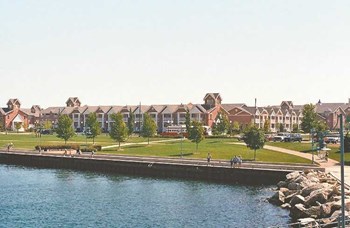
Nestled halfway between Chicago and Milwaukee, Kenosha, Wisconsin is a historic quaint community and the fourth largest city on the shores of Lake Michigan. Kenosha is bordered by the lake to the east and is bordered by the Town of Somers to the north, Bristol to the west and the village of Pleasant Prairie to the south.
Easily accessible by major highways and Union Pacific's Metra system, 90 minutes from Chicago, Kenosha continues to see population growth of 10 percent every five years; in fact since 1940 Kenosha has seen its population grow by more than 150 percent. In spite of the recent real estate downturn, sales of homes continue to be well-above the national average, with the average median sale price down less than 5 percent in the past year, as opposed to Chicago and Milwaukee where the median prices have dropped by more than 10 percent in the same period. Kenosha has a rich and vibrant history that illustrates the rich tapestry of American history. Though overshadowed by Chicago to the south and Milwaukee to the north, Kenosha boasts a thriving cultural scene as well as a vibrant economy.
From Fisheries to Automobiles
Prehistoric settlements unearthed by archeologists in the 20th century date back to the era of Wisconsin glaciation and show that the area was populated by Paleo-indians as far back as 13,500 years ago. The early name of the are by the Ojibwa Indians is reported as Masu-kinoja. This describes the place of spawning trout. There were thousands of fish entering the rivers from Lake Michigan during spawning season. Harvesting these fish provided food for the coming months.
In the 1830's, the first white settlers came as part of the Western Emigration Company. These settlers came primarily from Hannibal and Troy, New York, led by John Bullen, Jr. who sought land to purchase for a town. Originally, Bullen had sought to buy land in Milwaukee and Racine but was unable. Bullen found the land he was searching for along the Pike Creek in 1835. The settlement was first named Pike. In the mid 19th century, when the area had become a thriving port on Lake Michigan it was renamed Southport. (The lovely park on the southeast side of town is still named Southport, so is the elementary school, as well as several businesses.) In 1850 the residents decided to name the town Kenosha, as well as the county. The name is an anglicized version of the Native-American name for the town, Kinoja. Kenoshans refer to their town affectionately as “K-Town” and Keno.
In the 1900s, Kenosha grew rapidly as mass emigration from Europe continued. Irish, Italian, Polish and German immigrants settled in Kenosha due to the abundance of manufacturing jobs. (Particularly jobs in what would then have been considered high-tech industries.) Many of these immigrants were skilled craftsmen who left their indelible imprint on Kenosha's architecture, culture and history.
During this period, at the dawn of 20th century, Kenosha was a center of modern technology and became a major producer of automobiles and trucks. In 1900 the firm of Sullivan-Becker engineering built a prototype steam car. In 1916, Charles W. Nash established Nash motors in Kenosha which, after the purchase of the Detroit-based Hudson Motors Company in 1954, became American Motors Corporation (AMC). AMC constructed a large manufacturing facility and many of their most famous vehicles were assembled there. In 1960, AMC built a smaller facility, named AMC Lakeshore Plant, on the shores of Lake Michigan. This facility remained active until 1988 following the sale of AMC to Chrysler Motors.
In 1990, 10,000 spectators assembled to witness the demolition of the shuttered AMC Lakeshore Plant. The former industrial property was redeveloped into the upscale HarborPark. A rambling lakeside community of waterfront condominiums, a recreational marina, water-park, and promenades respite with artwork, sculptures and fountains.
Kenosha Today
Like many other cities in the Midwest, Kenosha has seen the majority of its manufacturing industries close or move, but unlike cities such as Detroit, Kenosha has adapted to these changes and has continued to thrive. Considered a “bedroom” community within the boundary of the Chicago-Milwaukee megalopolis, Kenosha is attracting so many new residents from Illinois that it is now often referred to as “Chicago's Northernmost Suburb.” Given the many transportation options available, as well as the overall charm of the community, Kenosha is very appealing to commuters. According to data provided by Kenosha County, 49 percent of Kenosha County's residents commute outside of the county to their jobs.
That's not to say that there aren't employment opportunities for residents. The Milken Institute reported in a June, 2009 study that Kenosha is still on the cutting edge of technology. The institute reported that Kenosha ranks in the national top-fifty high tech economies, in fact—high-tech industries inject nearly $3.5 billion into the local economy. The majority of this revenue is generated by pharmaceutical industries. Abbot Pharmaceuticals is the largest private employer in Kenosha, and continues to grow. The pharmaceutical giant recently purchased nearly 400 acres where the company plans to develop a new corporate campus.
Kenosha's economy has not been affected as severely as other cities across the nation and because of this Kenosha offers a wealth of educational, consumer, cultural, lifestyle and recreational options.
The city is home to six accredited universities and colleges. The local public school system boasts 24 elementary, six middle schools, seven charter schools, and six major high schools. According to the State of Wisconsin Department of Education, Kenosha's public school graduation rate is 84.1 percent, well-above the national average. The city also is home to several private schools as well.
Kenosha is also replete with parks and recreational facilities. The city is ringed by an emerald necklace of recreational city and county parks, and has eight miles of Lake Michigan shoreline frontage, nearly all of which is public. The city has 74 municipal parks, some of the more notable parks include: Petrifying Springs Park, which flanks the Pike River and was developed in the 1930s on the northwestern edge of the city, and is named for its artesian mineral water. The park features more than ten miles of trails which wind through the wooded park. Petrifying Springs Park also also features an 18-hole golf course. Another beautiful park is Hawthorn Hollow Nature Sanctuary and Arboretum which has three historic buildings and several trails for hiking. Many of the parks contain wonderful sculptures and works of art. Liberty Park has a sculpture of Abraham Lincoln by artist Charles Henry Niehaus as well as a sculpture by Daniel Burnham entitled Winged Victory. Perhaps the most well known park is Washington Park which features the oldest operating velodrome, an arena for bicycle racing, in the US. In the summertime, Kenosha's eight miles of beaches are a welcome relief from the summer heat.
Getting around Kenosha is quite easy. The city has a system of well maintained streets; an excellent bus service; and a classic electric streetcar system that was introduced in 2000. If your preferred mode of transportation is green, Kenosha is an exceptionally bike-friendly community. In addition to the extensive park system Kenosha has several museums including two outposts of the Smithsonian Institution. The Dinosaur Discovery Museum, a federal repository of fossils, is located at the Old Post Office on 56th Street; and the Civil War Museum offers an interactive experience detailing the role that Midwestern states played during and after the Civil War. The Kenosha Public Museum, on Lake Michigan, boasts a fossilized Wooly Mammoth discovered in 1992 in western Kenosha, and the museum also possesses an extensive fine art collection.
Throughout the year Kenosha hosts a thriving music scene. The Kenosha Pops Orchestra give free concerts at the Pennoyer Park Bandshell every Wednesday from mid-June through early August. The Kenosha Symphony Orchestra gives concerts at the historic Reuther Central Auditorium. Throughout the summer months there are numerous music festivals including the Peanut Butter and Jam Concert Series and the Lincoln Park Live! music series. On the way to these outdoor festivals stop by the farmer's market and pick up some of the local bounty.
Kenosha, and it's surrounding areas are also an oasis for true shop-a-holics. Downtown Kenosha is a reminder of days past with many small independently owned stores lining the streets, easily accessible by the electric street car. The town of Pleasant Prairie, just to the east of Kenosha, is a bargain-hunters paradise and home to the Pleasant Prairie Prime Outlet Mall.
Housing
For those thinking about moving to Kenosha they will be delighted with the housing choices available. The Kenosha area is about as diverse as they come. From condominiums and townhouses to established homes; from existing units to new construction; from lakefront living to more secluded rural properties; a new Kenoshan will find just the right surroundings. The new HarborPark neighborhood offers waterfront condo living, offering spectacular views of Lake Michigan, with all the modern amenities expected. Others may choose a more classically urban setting and settle into one of the many urban neighborhoods which are close to transportation, shopping, schools and recreation. Others still may opt for the rural countryside, communities surrounding inland lakes, farmland, woodlands and plenty of room to roam.
The types of units and buildings range from the modest to the luxurious, and the neighborhoods reflect the diversity of the residents. Like everywhere else in the nation Kenosha was hit by the recent recession, but not as hard as other communities in the Chicagoland area. Kenosha has certainly fared much better than Chicago or Milwaukee. While industry professionals are predicting declining prices approaching 10 percent or higher, for the upcoming year, in the Chicago and Milwaukee areas, in Kenosha however, housing prices are expected to decline less than 5 percent. These predictions seem to be on-target. A condo in the popular Harbor Place building located in the HarborPark neighborhood is presently selling for $399,000. The price of this unit, three bedrooms with views of Lake Michigan, is atypical for the HarborPark neighborhood, the median price for a unit is at $148,000, up 1.3 percent from last month. While a two bedroom condo, closer to Kenosha city center, is selling for around $132,000 or about 12 percent below the median price.
Looking Ahead
Buyers and sellers are still extremely nervous, but real estate professionals are beginning to feel a bit more confident. Most brokers in the Kenosha area believe that the market has bottomed out and the number of sales will begin to increase. The relative affordability of homes, the proximity to Chicago, and the fact that businesses and industries continue to grow in Kenosha, will continue to draw in new residents which will keep Kenosha the little evergreen jewel that it is right in the middle of Chicago and Milwaukee. n




Leave a Comment